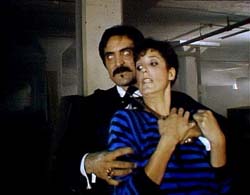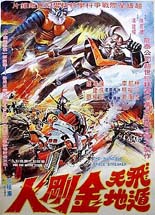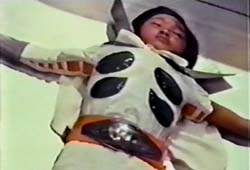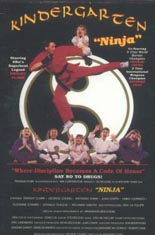
 Only one film in history is endorsed by California’s San Leandro Police Department — and I mean endorsed via an introduction that’s actually part of the movie, with the police chief addressing the camera when he’s not looking down to read his lines. That lucky sonofabitch is Kindergarten Ninja.
Only one film in history is endorsed by California’s San Leandro Police Department — and I mean endorsed via an introduction that’s actually part of the movie, with the police chief addressing the camera when he’s not looking down to read his lines. That lucky sonofabitch is Kindergarten Ninja.
Or, if you prefer, as the DVD label reads in all caps, “KIDNERGARDEN NINJA.”
Former San Francisco 49ers wide receiver and two-time Super Bowl champion Dwight Clark stars as former San Francisco Gold Rush football star Blade Steel, a playboy who manages a stable of at least 10 sex partners, uses “Hey, do you like French fries?” as a surefire pickup line and keeps a cooler of beer in his convertible. The latter helps earn him a DUI, but an argument can be made that fighting outside a Payless ShoeSource marks his true low point — either way, a judge assigns him to 90 days of community service at a children’s sports program.
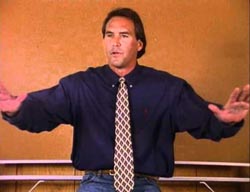 Meanwhile, in heaven, where the likes of Elvis Presley and Charlie Chaplin engage in stick fighting, Bruce Lee (Anthony Chan) must intervene in Blade’s life to become an angel. Thus, at a dojo where everyone drinks Coca-Cola Classic, Blade learns karate from a blind master (George Chung) named the Chosen Wan. Get it?
Meanwhile, in heaven, where the likes of Elvis Presley and Charlie Chaplin engage in stick fighting, Bruce Lee (Anthony Chan) must intervene in Blade’s life to become an angel. Thus, at a dojo where everyone drinks Coca-Cola Classic, Blade learns karate from a blind master (George Chung) named the Chosen Wan. Get it?
Such high-kickin’ skills will come in handy when Blade faces Hector Machette (Juan Chapa, Fight to Win), a drug dealer slinging the hot new street narcotic, Buzz. However, the cops aren’t too happy to have Blade’s assistance: “Hey, I don’t need no washed-up wide receiver vigilante tryin’ to play policeman out here.”
 Needless to say, Blade Steel does not become a ninja as the title hints, and he barely spends any time with the kids. He’s too busy romancing their teacher, Miss Linda (Suzanne Stanke), a goody-two-shoes who’s co-opted Peter Pan’s hairstyle. Together they go to a karaoke club that clearly is some crew member’s living room.
Needless to say, Blade Steel does not become a ninja as the title hints, and he barely spends any time with the kids. He’s too busy romancing their teacher, Miss Linda (Suzanne Stanke), a goody-two-shoes who’s co-opted Peter Pan’s hairstyle. Together they go to a karaoke club that clearly is some crew member’s living room.
This no-budget, shot-on-video movie will give viewers plenty to laugh at, but not in the way Chan and Chung intended. Doubling as the director and screenwriter, respectively, the two men are in on the joke — it’s just the wrong joke. They think Kindergarten Ninja is hilarious; it’s not. It is painfully inept on all levels imaginable, particularly with its wooden performers. On the scale of gridiron vets turning to acting, Clark may be the worst; by comparison, Hunter‘s Fred Dryer would excite Joseph Papp.
Kindergarten Ninja ends with an unrealized threat (“The End … for now”); a shout-out to Hot 97.7 Radio; and a reel of bloopers, as if the entire project weren’t one in itself. —Rod Lott


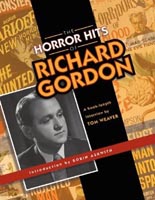
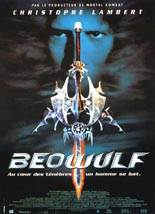
 The classic, Old English epic poem known as
The classic, Old English epic poem known as 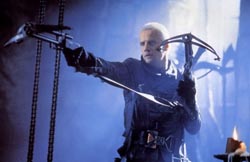
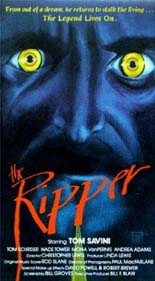
 The major problem with
The major problem with 